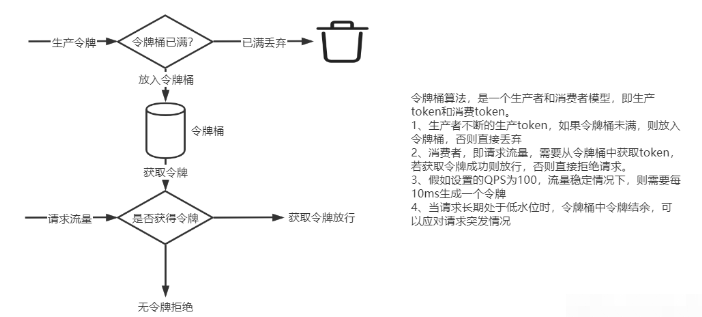本篇内容介绍了“Sentinel中冷启动限流原理WarmUpController是什么”的有关知识,在实际案例的操作过程中,不少人都会遇到这样的困境,接下来就让小编带领大家学习一下如何处理这些情况吧!希望大家仔细阅读,能够学有所成!
所谓冷启动,或预热是指,系统长时间处理低水平请求状态,当大量请求突然到来时,并非所有请求都放行,而是慢慢的增加请求,目的时防止大量请求冲垮应用,达到保护应用的目的。
Sentinel中冷启动是采用令牌桶算法实现。
令牌桶算法图例如下:

Sentinel中的令牌桶算法,是参照Google Guava中的RateLimiter,在学习Sentinel中预热算法之前,先了解下整个预热模型,如下图:

Guava中预热是通过控制令牌的生成时间,而Sentinel中实现不同:
不控制每个请求通过的时间间隔,而是控制每秒通过的请求数。
在Guava中,冷却因子coldFactor固定为3,上图中②是①的两倍
Sentinel增加冷却因子coldFactor的作用,在Sentinel模型中,②是①的(coldFactor-1)倍,coldFactor默认为3,可以通过csp.sentinel.flow.cold.factor参数修改
Sentinel中冷启动对应的FlowRule配置为RuleConstant.CONTROL_BEHAVIOR_WARM_UP,对应的Controller为WarmUpController,首先了解其中的属性和构造方法:
count:FlowRule中设定的阈值
warmUpPeriodSec:系统预热时间,代表上图中的②
coldFactor:冷却因子,默认为3,表示倍数,即系统最"冷"时(令牌桶饱和时),令牌生成时间间隔是正常情况下的多少倍
warningToken:预警值,表示进入预热或预热完毕
maxToken:最大可用token值,计算公式:warningToken+(2*时间*阈值)/(1+因子),默认情况下为warningToken的2倍
slope:斜度,(coldFactor-1)/count/(maxToken-warningToken),用于计算token生成的时间间隔,进而计算当前token生成速度,最终比较token生成速度与消费速度,决定是否限流
storedTokens:姑且可以理解为令牌桶中令牌的数量
public class WarmUpController implements TrafficShapingController {
// FlowRule中设置的阈值
protected double count;
// 冷却因子,默认为3,通过SentinelConfig加载,可以修改
private int coldFactor;
// 预警token数量
protected int warningToken = 0;
// 最大token数量
private int maxToken;
// 斜率,用于计算当前生成token的时间间隔,即生成速率
protected double slope;
// 令牌桶中剩余令牌数
protected AtomicLong storedTokens = new AtomicLong(0);
// 最后一次添加令牌的时间戳
protected AtomicLong lastFilledTime = new AtomicLong(0);
public WarmUpController(double count, int warmUpPeriodInSec, int coldFactor) {
construct(count, warmUpPeriodInSec, coldFactor);
}
public WarmUpController(double count, int warmUpPeriodInSec) {
construct(count, warmUpPeriodInSec, 3);
}
private void construct(double count, int warmUpPeriodInSec, int coldFactor) {
if (coldFactor <= 1) {
throw new IllegalArgumentException("Cold factor should be larger than 1");
}
this.count = count;
// 默认为3
this.coldFactor = coldFactor;
// thresholdPermits = 0.5 * warmupPeriod / stableInterval.
// warningToken = 100;
// 计算预警token数量
// 例如 count=5,warmUpPeriodInSec=10,coldFactor=3,则waringToken=5*10/2=25
warningToken = (int)(warmUpPeriodInSec * count) / (coldFactor - 1);
// / maxPermits = thresholdPermits + 2 * warmupPeriod / (stableInterval + coldInterval)
// maxToken = 200
// 最大token数量=25+2*10*5/4=50
maxToken = warningToken + (int)(2 * warmUpPeriodInSec * count / (1.0 + coldFactor));
// slope
// slope = (coldIntervalMicros - stableIntervalMicros) / (maxPermits- thresholdPermits);
// 倾斜度=(3-1)/5/(50-25) = 0.016
slope = (coldFactor - 1.0) / count / (maxToken - warningToken);
}
}举例说明:
FlowRule设定阈值count=5,即1s内QPS阈值为5,设置的预热时间默认为10s,即warmUpPeriodSec=10,冷却因子coldFactor默认为3,即count = 5,coldFactor=3,warmUpPeriodSec=10,则
stableInterval=1/count=200ms,coldInterval=coldFactor*stableInterval=600ms warningToken=warmUpPeriodSec/(coldFactor-1)/stableInterval=(warmUpPeriodSec*count)/(coldFactor-1)=25 maxToken=2warmUpPeriodSec/(stableInterval+coldInterval)+warningToken=warningToken+2warmUpPeriodSeccount/(coldFactor+1)=50 slope=(coldInterval-stableInterval)/(maxToken-warningToken)=(coldFactor-1)/count/(maxToken-warningToken)=0.016
接下来学习,WarmUpController是如何进行限流的,进入canPass()方法:
public boolean canPass(Node node, int acquireCount, boolean prioritized) {
// 获取当前1s的QPS
long passQps = (long) node.passQps();
// 获取上一窗口通过的qps
long previousQps = (long) node.previousPassQps();
// 生成和滑落token
syncToken(previousQps);
// 如果进入了警戒线,开始调整他的qps
long restToken = storedTokens.get();
// 如果令牌桶中的token数量大于警戒值,说明还未预热结束,需要判断token的生成速度和消费速度
if (restToken >= warningToken) {
long aboveToken = restToken - warningToken;
// 消耗的速度要比warning快,但是要比慢
// y轴,当前token生成时间 current interval = restToken*slope+stableInterval
// 计算此时1s内能够生成token的数量
double warningQps = Math.nextUp(1.0 / (aboveToken * slope + 1.0 / count));
// 判断token消费速度是否小于生成速度,如果是则正常请求,否则限流
if (passQps + acquireCount <= warningQps) {
return true;
}
} else {
// 预热结束,直接判断是否超过设置的阈值
if (passQps + acquireCount <= count) {
return true;
}
}
return false;
}canPass()方法分为3个阶段:
syncToken():负责令牌的生产和滑落
判断令牌桶中剩余令牌数
如果剩余令牌数大于警戒值,说明处于预热阶段,需要比较令牌的生产速率与令牌的消耗速率。若消耗速率大,则限流;否则请求正常通行
仍然以count=5进行举例,警戒线warningToken=25,maxToken=50
假设令牌桶中剩余令牌数storedTokens=30,即在预热范围内,此时restToken=30,slope=0.016,则aboveToken=30-25=5
由斜率slope推导当前token生成时间间隔:(restToken-warningToken)*slope+stableInterval=5*0.016+1/5=0.28,即280ms生成一个token
此时1s内生成token的数量=1/0.28≈4,即1s内生成4个token
假设当前窗口通过的请求数量passQps=4,acquiredCount=1,此时passQps+acquiredCount=5>4,即令牌消耗速度大于生产速度,则限流
如果剩余令牌数小于警戒值,说明系统已经处于高水位,请求稳定,则直接判断QPS与阈值,超过阈值则限流
接下来分析Sentinel是如何生产及滑落token的,进入到syncToken()方法:
获取当前时间秒数currentTime,与lastFilledTime进行比较,之所以取秒数,是因为时间窗口的设定为1s,若两个时间相等,说明还处于同一秒内,不进行token填充和滑落,避免重复问题
令牌桶中添加token
当流量极大,令牌桶中剩余token远低于预警值时,添加token
处于预热节点,单令牌的消耗速度小于系统最冷时令牌的生成速度,则添加令牌
通过CAS操作,修改storedToken,并进行令牌扣减
protected void syncToken(long passQps) {
long currentTime = TimeUtil.currentTimeMillis();
// 获取整秒数
currentTime = currentTime - currentTime % 1000;
// 上一次的操作时间
long oldLastFillTime = lastFilledTime.get();
// 判断成立,如果小于,说明可能出现了时钟回拨
// 如果等于,说明当前请求都处于同一秒内,则不进行token添加和滑落操作,避免的重复扣减
// 时间窗口的跨度为1s
if (currentTime <= oldLastFillTime) {
return;
}
// token数量
long oldValue = storedTokens.get();
long newValue = coolDownTokens(currentTime, passQps);
// 重置token数量
if (storedTokens.compareAndSet(oldValue, newValue)) {
// token滑落,即token消费
// 减去上一个时间窗口的通过请求数
long currentValue = storedTokens.addAndGet(0 - passQps);
if (currentValue < 0) {
storedTokens.set(0L);
}
// 设置最后添加令牌时间
lastFilledTime.set(currentTime);
}
}
private long coolDownTokens(long currentTime, long passQps) {
long oldValue = storedTokens.get();
long newValue = oldValue;
// 添加令牌的判断前提条件:
// 当令牌的消耗程度远远低于警戒线的时候
if (oldValue < warningToken) {
// 计算过去一段时间内,可以通过的QPS总量
// 初始加载时,令牌数量达到maxToken
newValue = (long)(oldValue + (currentTime - lastFilledTime.get()) * count / 1000);
} else if (oldValue > warningToken) {
// 处于预热过程,且消费速度低于冷却速度,则补充令牌
if (passQps < (int)count / coldFactor) {
newValue = (long)(oldValue + (currentTime - lastFilledTime.get()) * count / 1000);
}
}
// 当令牌桶满了之后,抛弃多余的令牌
return Math.min(newValue, maxToken);
}“Sentinel中冷启动限流原理WarmUpController是什么”的内容就介绍到这里了,感谢大家的阅读。如果想了解更多行业相关的知识可以关注亿速云网站,小编将为大家输出更多高质量的实用文章!
免责声明:本站发布的内容(图片、视频和文字)以原创、转载和分享为主,文章观点不代表本网站立场,如果涉及侵权请联系站长邮箱:is@yisu.com进行举报,并提供相关证据,一经查实,将立刻删除涉嫌侵权内容。